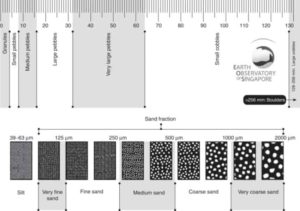
What is Grain Size?
Grain size is the diameter of singular sediment grains, or the lithified particles in clastic rocks. The term may apply to other granular materials, too. This differs from the size of a crystallite, which refers to the size of a single crystal within a particle or grain. Many crystals can be composed of a single grain. Granular material can vary from very small colloidal particles to boulders, through clay , silt , sand, gravel, and cobbles.
The size of a compact, three-dimensional object such as a sedimentary grain might be indexed by some measure of its volume, or by some linear measure of its geometry. For geometrically regular objects, either carries equivalent information. For irregular objects, including sediment grains, they do not. Both approaches have been used for characterizing grain size.
Size and shape are fundamental properties of clastic sediments. The distributions of size and shape in sediment deposits influence and index other important physical properties of the sediment, such as porosity, permeability, and surface roughness, they carry important information about the origin of a deposit, they affect the stability of the deposit, and they influence habitat quality for small organisms.
How is grain size measured?
The analysis of the grain size is a typical laboratory test carried out in the field of soil mechanics. The purpose of the analysis is to deduct the distribution of soil particle size.
The analysis is carried out using two techniques. Sieve Grain Size Analysis can measure the particle size ranging from 0.075 mm to 100 mm. Any grain categorization greater than 100 mm will be conducted visually whereas particles smaller than 0.075 mm can be distributed using the Hydrometer Method.
Sieve Grain Size Analysis is the experiment done using a set of sieves with varying mesh sizes. Each sieve has openings of a certain size with squared shapes. The sieve separates larger particles from smaller ones, and the soil sample is distributed in 2 quantities. The sieve retains the grains with diameters larger than the size of the openings, while the sieve passes through smaller-diameter grains. The test is conducted by placing a series of sieves with progressively smaller mesh sizes on top of each other and passing the soil sample through the stacked sieve “tower”. Therefore, the soil particles are distributed as they are retained by the different sieves. A pan is also used to collect those particles that pass through the last sieve (No. 200).
what grain size can streams transport?
Sediment moved by water can be larger than sediment moved by air because water has both a higher density and viscosity. In typical rivers the largest carried sediment is of sand and gravel size, but larger floods can carry cobbles and even boulders.
In a stream, the most easily eroded particles are small sand grains between 0.2 mm and 0.5 mm. Anything smaller or larger requires a higher water velocity to be eroded and entrained in the flow.
Grain Size International scale
ISO 14688-1:2002, establishes the basic principles for the identification and classification of soils on the basis of those material and mass characteristics most commonly used for soils for engineering purposes. ISO 14688-1 is applicable to natural soils in situ, similar man-made materials in situ and soils redeposited by people.
| Name | Size range (mm) | Size range (approx. in) | |||
| Very coarse soil | Large boulder | LBo | >630 | >24.8031 | |
| Boulder | Bo | 200–630 | 7.8740–24.803 | ||
| Cobble | Co | 63–200 | 2.4803–7.8740 | ||
| Coarse soil | Gravel | Coarse gravel | CGr | 20–63 | 0.78740–2.4803 |
| Medium gravel | MGr | 6.3–20 | 0.24803–0.78740 | ||
| Fine gravel | FGr | 2.0–6.3 | 0.078740–0.24803 | ||
| Sand | Coarse sand | CSa | 0.63–2.0 | 0.024803–0.078740 | |
| Medium sand | MSa | 0.2–0.63 | 0.0078740–0.024803 | ||
| Fine sand | FSa | 0.063–0.2 | 0.0024803–0.0078740 | ||
| Fine soil | Silt | Coarse silt | CSi | 0.02–0.063 | 0.00078740–0.0024803 |
| Medium silt | MSi | 0.0063–0.02 | 0.00024803–0.00078740 | ||
| Fine silt | FSi | 0.002–0.0063 | 0.000078740–0.00024803 | ||
| Clay | Cl | ≤0.002 | ≤0.000078740 | ||
Reference:
Wikipedia
Grain size and shape : DOI: https://doi.org/10.1007/3-540-31079-7_104
Grain Size









